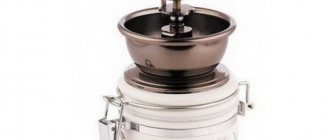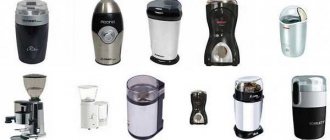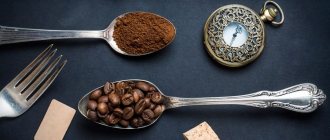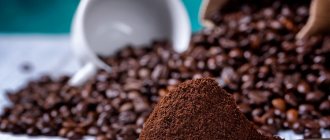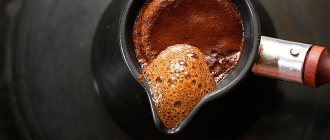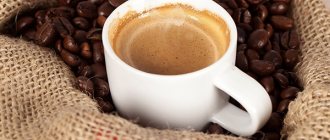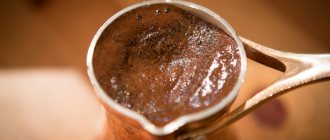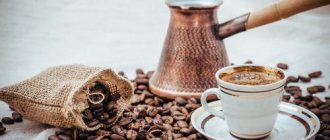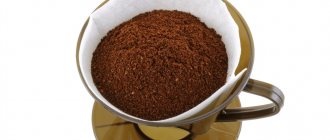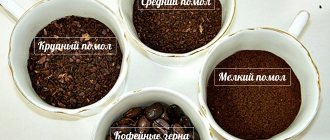Before grown, roasted coffee beans combine with water, become the basis of a magical drink and give us the incomparable joy of coffee drinking, they must be ground, i.e. crushed to a powdery free-flowing product. When buying granulated sugar in a store, we are not particularly interested in the size of the grains of sand; the product will be sweet in any case. But if you need coffee, the degree of grinding of the beans interests connoisseurs no less than its variety. The shades of coffee taste depend on it. A mistake in choice can be fatal and ruin even an expensive exclusive product. This cannot be allowed, so let’s dwell on this important topic.
Happy grinding, coffee lover!
Coffee beans are ground based on the method of preparing the drink. For each manual or automated method, there are specific types of coffee grinding. Let's start with this.
There are five main types of grinding; see their names, features and specific application in the table.
| № | Grinding name | According to international classification | Particle size of ground coffee beans | Where is it used to make coffee? |
| 1 | Large or rough | course grind | Large particles up to 0.8 mm | In French presses, geyser-type coffee makers |
| 2 | Average | medium grind | Grains the size of a fine grain of sand | Universal option, optimal for most brewing methods |
| 3 | Thin or small | fine grind | The ground mass looks like very fine sand or coarse flour | For brewing in drip coffee makers, espresso machines |
| 4 | Fine grind for espresso | fine espresso grind | Special very fine grinding made by coffee grinders built into the coffee machine | If you do this kind of grinding to brew espresso in a household carob-type coffee machine, you need to grind the beans in a coffee grinder for at least 25 seconds |
| 5 | Ultra-thin, “to dust” | pulverized | Looks like loose powder or fine flour (highest grade) | For brewing coffee in a Turk |
No matter how extensive the selection of ground coffee is, a real coffee lover would prefer to go to a specialty store, buy freshly roasted beans there and grind them at home immediately before preparing the drink. That's why every true coffee lover has his own coffee grinder, which he keeps as a relic.
Coffee grinding
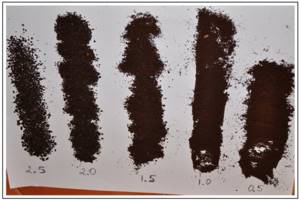
Grinding coffee is, at first glance, a very insignificant detail. But if you don’t pay enough attention to it, you risk completely ruining the invigorating drink. The coffee grind should be selected depending on the preparation method. Let's try to figure out how the size of the crushed grains can affect the quality of the drink.
Coffee grinding is calculated for a specific extraction time. The smaller the grains, the less time it takes for the grains to release all the aromatic oils to the drink. In addition, water passes through very fine powder with great difficulty, so it is undesirable to use it in coffee machines.
What coffee grind should you choose? To get the answer to this question, check out the approximate classification. Of course, an experienced barista is able to determine by eye the category to which coffee grinding belongs, but non-professionals are better off remembering what coarseness will be optimal for preparing their favorite drink. So, coffee grinding is divided into five main categories:
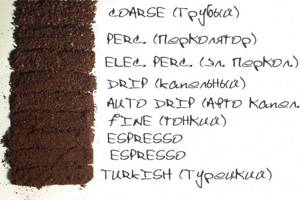
Coarse grind is the coarsest coffee grind, the grain particle size reaches 0.8 mm. Optimal extraction requires approximately 4 – 6 minutes. This grind is best suited for preparing an invigorating drink in a French press.
Medium grind - grinding with particles whose size is 0.5 mm. It takes 6 minutes to prepare a drink from such raw materials. This coffee grind is optimal for drip coffee makers with metal filters. Grinding coffee for coffee makers with paper filters. Technically this is also a medium grind, but a little finer than standard. The particle size is approximately 0.4 mm. Extraction in this case will also take 6 minutes.
Fine grind is a coffee grind that is best suited for a geyser coffee maker. The grain particles do not exceed 0.3 mm in size. Such a fine grind of coffee allows you to reduce the preparation time of the drink to the number of seconds it takes for water to pass through a coffee tablet.

Ultrafine (pulverized) - grind coffee, reminiscent of flour. It is also called Turkish or “into the dust.” The grain particles have a size not exceeding 0.075 - 0.125 mm. The preparation time for a drink from this coffee is approximately 1 minute. It is best suited for cooking in a cezve.
Modern coffee grinders allow you to obtain exactly the grind of coffee that is necessary for your usual brewing method. Electric units are especially convenient in this regard. You can simply set the desired characteristics on them, and they themselves will provide the desired coffee grind.
You can also purchase already ground grains. Of course, such a product cannot be stored for a long time, but it also has a number of advantages. Firstly, you can get the desired coffee grind by simply checking the label on the package. Secondly, enterprises create a product with a more uniform particle size using special sieves.
Coffee grinding is one of those nuances that can have a decisive influence on the taste of an invigorating drink. Experiment, but do not forget about the recommendations of professionals. Then you will get the perfect coffee every time.
The most popular products in the category - Coffee beans
Lavazza coffee beans Qualita Oro 1 kg 1382 rub.
| Paulig Arabica coffee beans 1 kg 676 rub. | Santo Domingo coffee beans Puro Cafe 454 g 900 rub. | Hausbrandt Espresso coffee beans 1 kg 2085 rub. | Goppion Caffe coffee beans JBM 1 kg 3265 rub. |
| Diemme coffee beans Miscela Excellent 1 kg 3504 rub. |
The most popular products in the category - Ground coffee
| Lavazza ground coffee Oro 250 g 377 rub. | Paulig Espresso Originale ground coffee 250 g 150 rub. | Dallmayr ground coffee Prodomo 250 g 350 rub. | Ground coffee Me Trang Arabica 250 g 404 rub. | Hausbrandt ground coffee Espresso 250 g 681 rub. |
| Goppion Caffe ground coffee JBM (JaBlMo) 250 g 965 rub. |
How does grinding grains affect the taste?
First of all, the degree of grinding of coffee beans affects:
- on the intensity of taste;
- on the saturation and density of the drink.
80% of the taste of coffee comes from the bean. But even the pleasant sourness of high-quality Arabica can be drowned out by grinding too finely. And in the bitter variety, level out the level of bitterness by coarse grinding. Small fractions reveal all the nuances of flavor present in coffee beans, because extraction under such conditions is more intense. The total surface area of microparticles is much greater than that of grains of the same volume of a coarsely ground product. Therefore, the drink acquires richness, thickness and density. Finely ground coffee always has a fluffy and tight foam.
Coffee beans contain less than half of the total mass of valuable components soluble in water. To get a fragrant and healthy drink, you need to extract the maximum amount of coffee from the depths and transfer it to water. This process of “removal” is called extraction.
You shouldn’t get carried away with increasing the degree of grinding; each specific situation requires its individual selection. Particles that are too small are undesirable for preparing a drink in an automatic coffee machine; they will quickly clog its filters. Ultra-fine grinding is not suitable for brewing coffee in a French press; microfractions will pass through the sieve. And it is ideal for brewing in a Turk, brewing in a mug, or for a drip coffee maker.
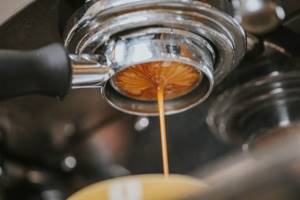
Features of grinding types and coffee preparation methods
The uniqueness of each person forces manufacturers of certain goods to present their products in an assortment sufficient for absolutely everyone to find something for themselves. This is the reason for the variety of coffee varieties in stores. However, the taste and quality of the finished coffee is affected not only by the variety, but also by grinding. His choice depends on the way you intend to prepare this unique and divine drink. And it doesn’t matter whether you buy bean coffee and grind it yourself or buy it already ground, every lover of the above-mentioned drink should know something about the types of grinding.
Types of coffee grinding
If you turn to different sources, you may be left bewildered: some claim that there are three main types of grinding (that is, particle sizes) of coffee, others insist that there are four, and still others even talk about five!
Agree, it’s difficult not to get confused. We will focus on the fact that there are five main types of grinding - and a sufficient number of additional ones. The main types include:
- Coarse grind. The size of coffee particles reaches 0.8 mm, but ideally should not exceed this figure. Extraction (brewing) occurs in 6-8 minutes. Coarse powder is ideally suited for use in piston coffee makers (French press) or coffee pots of various types.
- Medium grind . The size of coffee particles does not exceed 0.5 mm. This is the most “unpretentious” type of grinding, as it is suitable for almost any type of brewing. A drink from such a powder can be prepared either in a coffee pot or coffee maker, or in other known ways. It also turns out very tasty in a French press. Brewing medium-ground coffee takes 4-6 minutes.
- Fine grind. Particle size – no more than 0.3 mm. Extraction requires 1 to 4 minutes. Indispensable for coffee makers with filters.
- Fine espresso grind. As the name implies, it is used to prepare espresso in special coffee machines designed for brewing this particular drink. Special grinding in this case is required due to the special brewing process: in espresso coffee makers, a stream of hot water under high pressure passes through a filter with ground coffee. This happens in about 30 seconds, and during this time the required amount of flavoring and aromatic substances should be extracted from the powder.
- Ultrafine (powdery) grinding (pulverized). The particle size barely reaches 0.1 mm. A drink made from such powder is boiled in a cezve. It is this grinding that is necessary to prepare the famous Turkish coffee.
It would seem that since “medium” ground coffee is almost universal, why not purchase it exclusively? The fact is that the particle size affects the quality of the finished drink, and in this case everything depends solely on your preferences and time. Fine grinding gives the coffee a more refined, subtle taste. In addition, it is suitable for cooking methods that take little time. But coarsely ground coffee produces a drink “with character” - with a bright, complex, original, somewhat rough taste. It will take longer to cook. But you don’t need any special equipment: in some cases, a coffee pot is enough.
Features of coffee preparation
While preparing a drink in a coffee machine is not at all difficult, just follow the instructions for it, but not everyone knows how to do it in a Turk (or, as it is also called, cezve).
However, this is also not difficult. There are many options for making coffee over a fire in a Turk. So, in some recipes it is recommended to add sugar and spices exclusively to the finished drink, in others - before adding water to the cezve, in others - even before you add coffee. Some people stir the drink during the preparation process, while others think that this is strictly forbidden. The foam that forms on the surface when the liquid is heated is also dealt with differently: as soon as it forms, it is removed and laid out in cups, allowing a new one to appear, which is also removed, or left on the surface. The amount of ground coffee per cup depends on preference (and health) - from one teaspoon to a couple of tablespoons. And to reveal the taste, some people add a pinch of salt to the drink at the beginning of cooking...
But there are general principles for making coffee in a cezve. Copper Turk is ideal for preparing a delicious drink. But this does not mean that without it you cannot make good coffee. A brass Turk would also work perfectly.
Features of making coffee in a cezve
Use cold, even ice-cold water (spring, well, or filtered tap water). The finer the coffee grind, the better the result. The drink in the Turk is brewed over low heat.
- First, slightly heat the empty cezve over low heat, then pour ground coffee into it.
- Heat it up a little more, then you can pour in the water (if you are using spices and sugar, you can add them to the heated ground coffee, stir, put it back on the stove for a while and then pour in the liquid).
- Do not fill the Turk with water completely, but only to the narrowest point.
- When the coffee begins to rise, the Turk should be removed from the heat just at the moment when it seems to begin to “run away.” It is best to heat it to this temperature several times, so the drink will be more aromatic. Under no circumstances should coffee boil.
- Pour the finished drink into heated cups (to heat, you need to pour boiling water into them and then pour them out) along with the grounds.
- Making coffee on sand is carried out in approximately the same way as on a fire, only the cezve is not placed on the burner, but is buried in the heated sand. This way the drink warms up more evenly, which provides it with a special taste.
At home, you can take clean fine sand, pour it into a deep frying pan or pan, heat it on the stove and bury the Turk in it so that there is also a layer of sand under the cezve. If it is not enough, mix with salt. Otherwise, the process is practically no different from cooking on a burner, except that you will have to not just place the Turk, but bury it, and several times. Before serving, let the drink steep for a couple of minutes in the cezve.
French Press Grinding
Another popular option for making coffee is to use a special coffee pot called a French press. Connoisseurs claim that this is one of the most delicious and aromatic methods. In this case, coarse or medium grind coffee is perfect. The water with which the powder will be brewed should reach 90-96 degrees.
- Before pouring coffee into the vessel (every 220-250 ml of water you will need 4 tablespoons of coffee, however, it’s a matter of taste), warm it up: rinse with hot water and wipe.
- Pour hot water over the powder so that the liquid does not reach the edges of the flask, leaving a distance of about 2 fingers.
- Stir the drink with a wooden spoon (stick), cover with the lid, turning it so that the spout of the coffee pot is closed.
- The piston must be raised.
- Let the coffee brew for about 3-4 minutes, then you can stir it again, return the lid, but this time so that the spout of the vessel opens.
- Now you can carefully and slowly lower the plunger and pour the drink into the heated cups.
We wish you to find the best and most delicious way to make coffee for yourself!
Types of household coffee grinders
This section will be useful for beginner coffee fans who have not yet acquired their own mill and buy ready-ground coffee. I do not rule out that some of the experienced “coffee makers” will want to purchase another copy in reserve or will consider it necessary to retire an old coffee grinder.
Home coffee grinders, three main types:
Knife
The coffee beans are cut into small pieces with sharp knives. The degree of grinding depends on the duration of operation of the knives. You can load from 30 g to 90 g of coffee into a knife grinder, depending on the model. There are modifications:
- with a “START” button, which is pressed and held until the end of grinding;
- with a “START” button, pressed only to turn on the unit;
- with automatic activation by closing the lid.
The advantage of knife coffee grinders is their affordable price and ease of use. These models are the most popular and best-selling. The disadvantage is the uneven grinding of the grains; the grains will always have different sizes - some will be larger, some smaller. It is impossible to regulate this process. This type of grinding will not matter if you brew coffee in a Turk, but if you need to load it into the ladle of a carob coffee machine, it is better to achieve uniform grinding.
Reference. Home coffee grinders with a rotary blade from Bosch have proven themselves to be excellent. The high speed of rotation of the knife ensures fast grinding of grains, cost from 1,500 rubles. Cheaper, more practical Polaris and Viconte units are also popular.
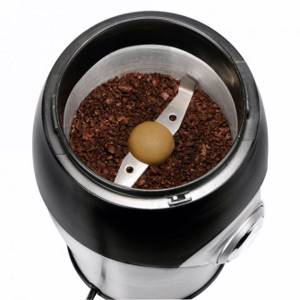
Millstones
Coffee grinders with metal millstones will ensure uniform grinding. The model is equipped with a regulator that will help you select and ensure the desired grinding level. Coffee grinders have up to 14 grinding levels. You can load up to 300 g of coffee at a time.
Burr grinders are considered safer than knife grinders because the grinders are located inside the unit. They cost 2–3 times more, so they are less popular.
Reference. Good burr coffee grinders cost at least 3,500 thousand rubles. The leading brands in popularity are models from De'Longhi, Nivona, and Polaris. Reliable design, choice of grinding level, high performance, and the presence of additional options (for example, a timer) are the main advantages of burr coffee grinders.
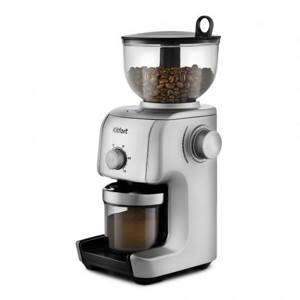
Manual
There are knife and millstone ones. Experienced coffee lovers are convinced that only with the help of such a device can they prepare beans for making real coffee. In electric coffee grinders, the beans overheat and lose some of their aroma and absorb foreign odors from plastic.
In a hand mill, the desired degree of grinding is achieved using your hands. The mood and aura of a person are conveyed to the ground grains. At the same time, monotonous movements and a stunning aroma have a beneficial effect on the “miller”, forcing him to concentrate on the process and distract from negative emotions. The psychological technique works: “And let the whole world wait...”. The only negative point that you can’t argue with is that a manual coffee grinder is uncomfortable to use at first. She does not want to lie securely in the hand and tends to slip out. This nuance is eliminated with the advent of experience and skill.
Reference. The hand mills are magnificent, made in oriental style and equipped with ceramic millstones. You can also adjust the degree of grinding and get the same grain size. Tima burr coffee grinders are very beautiful and reliable (from 2500 rubles). High-quality grinding is provided by cylindrical products from TIAMO (from 2900 rubles). The Kamille model will decorate your kitchen with a spectacular vintage look.
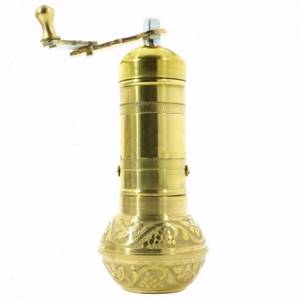
Automatic devices and grinding
Grinding coffee for a coffee machine has its own characteristics. In most modern devices, the grinding degree is an adjustable function. The regulator sets the level that is suitable for a specific type of coffee. Making the right choice is very important, since the type of grinding significantly affects the taste of the future drink. Coffee shop visitors can only rely on the experience and skill of the barista.
Note. If the coffee machine uses one favorite type of coffee, then the set grinding degree does not need to be changed. It is not prohibited to use it for other varieties and never switch it at all. But then the advantages of the new variety may not be fully revealed. It is undesirable to ignore the availability of switching grain grinding levels.
The time for pouring water to prepare espresso is the same, it does not depend on whether the water passes through large or dusty particles. But the taste of the drink will differ significantly; the size of the “coffee particles” affects it directly and strongly.
The volume of water poured through the thickness of the ground beans also affects the taste of coffee. An increased or decreased amount of liquid passing through particles of different grinding will change the taste of the drink in the cup. The degree of roasting will also affect it; the more intense it is, the more “bitterness” you will feel in the taste.

